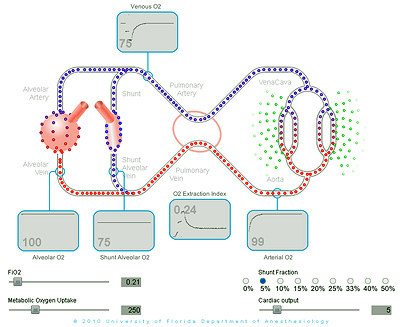
Simulation of Oxygen Circulation
To reference this educational web simulation according to the APA style for Web references, use: Downs JB, Lizdas D, Gravenstein N, Lampotang S.(2010): Web Simulation of Oxygen Circulation. Retrieved <insert date of retrieval here>, from University of Florida Department of Anesthesiology Virtual Anesthesia Machine Web site: /simulations/o2circ.html |
|
||||||||||||||||||||||||||
|
This simulation of oxygen circulation in the adult body was developed by the University of Florida Department of Anesthesiology and is available for free along with many other such simulations and animations at /wip.html. As the simulation runs, you can see a simplified circulatory system with pulmonary and systemic blood flow. Each blood particle in the circuit represents 20 mL of blood and flows through the circulatory system in a physiologically realistic time. Oxygen is picked up in the ventilated lung tissue in the pulmonary half of the circulation, while none is transferred in the shunted or non-ventilated lung tissue. Perfused tissues pull the oxygen they need out of the blood in the systemic half of the circulation (oxygen consumption-VO2). Oxygen saturation values are shown and graphed over the last 2 minutes for various locations along the circulatory system. The arterial O2 plot is essentially a pulse oximeter finger probe reading. The other plots offer the same information, but gathered at locations normally inaccessible in patients, such as the pulmonary vessels and venous system. The FiO2 slider controls the inspired oxygen percentage ranging from 15% (below room air which is 21%) up to 100%. See the second page for FiO2 values provided by common oxygen delivery devices. The shunt fraction slider determines what percentage of blood flow goes through ventilated lung tissue vs. non-ventilated. Some causes of shunting are mainstem bronchial intubation, pneumothorax, and mixing of blood between the left and right sides of the heart. Cardiac output is the amount of blood pumped by the heart every minute. Oxygen uptake by the lungs (VO2) is determined by how much oxygen the body tissues require and thus how much they will take from capillary blood. For example, both cardiac output and oxygen uptake would increase during exercise. The interaction of cardiac output, shunting and oxygen consumption has a great deal of influence on resulting values of arterial and venous oxygen saturations. For example, a patient with severe infection in the lungs will have a large shunt and increased VO2, but the cardiac output will increase so that oxygen saturation will be maintained at a higher level. The utilization of supplemental oxygen at levels commonly employed (30 to 40%) has little impact on arterial oxygen saturation when shunt is elevated. This illustrates the importance of reducing shunt, rather than increasing inspired oxygen to treat the arterial hypoxemia caused by shunt. Further, it can be seen that an increase in inspired O2 of any amount, even 100%, will not increase VO2, but will only increase arterial and venous saturation by an equal amount.
The Oxygen Circulation interactive model was developed with the financial support of our friends, Mr. James H. Lybass and his dear wife, Mrs. Joh-Nana Lybass. We appreciate their sincere commitment to the UF College of Medicine's Department of Anesthesiology along with their belief in the future of web-based patient simulation and its unbelievable impact on the future of worldwide education. |
|||||||||||||||||||||||||||
